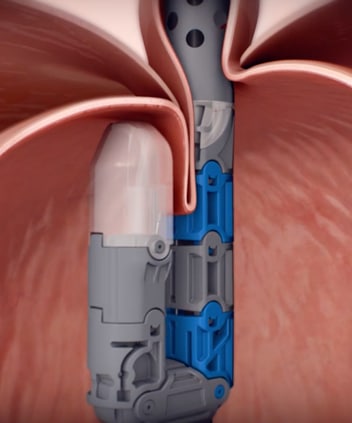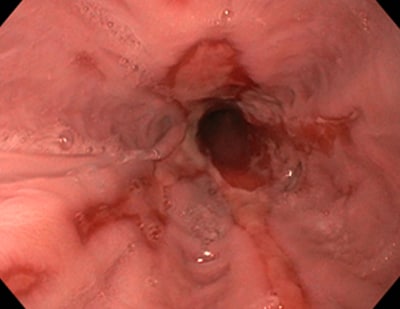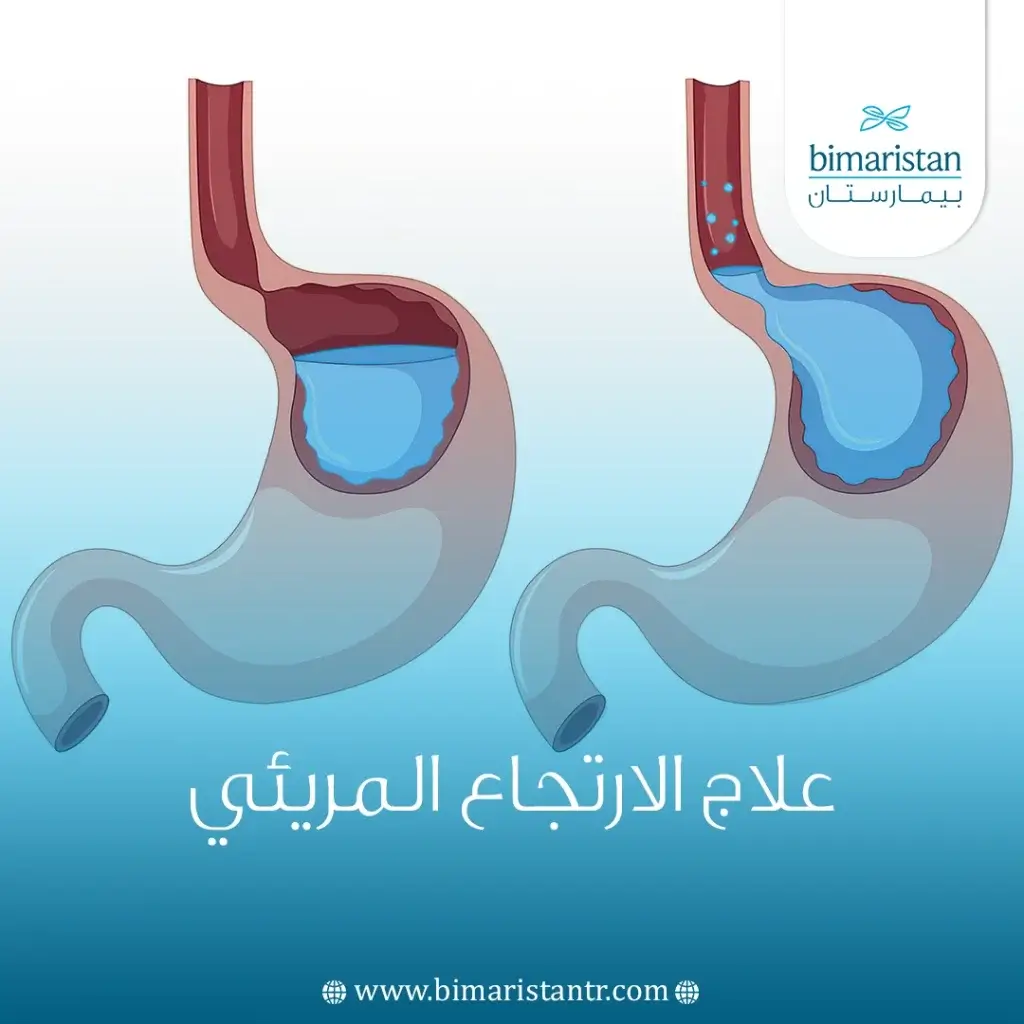يحصل مرض ارتجاع المريء نتيجة عودة حمض المعدة بشكل عكسي للمري مما يسبب أعراض مزعجة تستدعي العلاج، لحسن الحظ أولت تركيا علاج الارتجاع المريئي أهمية خاصة.
ما هو مرض الارتجاع المريئي؟
يعرف الارتجاع المعدي المريئي (GERD) بعودة مكونات المعدة بشكل عكسي إلى المري نتيجة عدم الانغلاق المناسب لمعصرة المري السفلية الأمر الذي يؤدي لعبور حمض المعدة بالطريق المعاكس عبر المري إلى الفم.
ارتداد الحمض المعدي أو الحموضة أو الشعور بالحرقة تحدث بشكل طبيعي للجميع من حين إلى آخر لكن في حال حصوله بشكل مستمر ومتكرر لفترة طويلة قد يدل ذلك على الإصابة بالارتجاع المريئي.
إذاً فالسبب الرئيسي للارتجاع المريئي هو خلل على مستوى معصرة المري السفلية.
أسباب الارتجاع المريئي
في حالة الارتجاع المريئي فإن مصرة المري السفلية لا تنغلق بشكل مناسب او تفتح بشكل متكرر خارج أوقات تناول الطعام إما بسبب انخفاض ضغط مصرة المري أو بسبب الارتخاءات المتكررة للمصرة أو بسبب ارتفاع الضغط ضمن البطن حيث يوجد بعض العوامل التي تساهم في حدوث ذلك نذكر منها:
- بعض الأطعمة تسبب انخفاض ضغط مصرة المري (الشوكولا والأطعمة الحارة)
- بعض الادوية تقوم بإرخاء مصرة المري السفلية (النيتروغليسرين)
- اسباب ترفع الضغط ضمن البطن (السمنة أو الحمل والإمساك المزمن)
- التأخر في إفراغ محتويات المعدة
- فتق الحجاب الحاجز الذي يؤدي لارتفاع الضغط
اعراض الارتجاع المريئي
يعاني مرضى ارتجاع المريء من أعراض عديدة من أهمها:
- الحرقة هي العرض الأشيع للارتجاع المريئي (عبارة عن الشعور بحرقة مؤلمة في الصدر)
- القلس المتكرر أو عودة الحمض إلى الفم
- صعوبة في البلع
- بحة صوت
- سعال مزمن
- ألم بالحلق والصدر
- عدم القدرة على النوم
- نفس كريه الرائحة
- بكاء مستمر عند الأطفال ورفض الطعام
علاج الارتجاع المريئي في تركيا
يمكن علاج الارتجاع المريئي بعدة طرق بحسب شدة الحالة ورغبة المريض فمن الممكن أن يتم علاج ارتجاع المرئ بالمنزل عبر الأدوية أو يمكن اللجوء لعمل جراحي يخفف من الأعراض ويحسن جودة الحياة عند المصاب.
علاج الارتجاع المريئي بالحمية وتغيير نمط الحياة
يعتبر الخط الأول للعلاج عند المرضى القادرين على إجراء تعديلات على نمط حياتهم مثل:
- خسارة الوزن (في حال السمنة)
- الابتعاد عن الأطعمة التي تخفض من ضغط مصرة المري السفلية (الشوكولا والدسم)
- تجنب الأكل قبل النوم
- عدم تناول وجبات بكميات كبيرة
- الإقلاع عن التدخين والتخلص من الكحول
علاج الارتجاع المريئي بالأدوية
في حال لم ينفع العلاج بتغيير نمط الحياة في تحسين حالة المريض يقوم الطبيب عندها بوصف الأدوية للتخفيف من الأعراض.
إن أفضل علاج لارتجاع المريء والتهاب المعدة في الصيدليات هو:
الأدوية المضادة للحموضة
وهي الأساس في علاج الإرتجاع المريئي دوائياً حيث تعطى بعد كل وجبة طعام وقبل النوم، تعمل عبر التقليل من حموضة المعدة مما يريح المريض من أعراض الارتجاع المريئي، أشيع نمطين لمضادات الحموضة هي ادوية حاصرات مستقبلات ال H2 ومثبطات مضخة البروتون ppi.
جراحة علاج ارتجاع المريء في تركيا
عندما لا يستجيب المريض للعلاجات السابقة وتزداد أعراض ارتجاع المريء شدةً يتم اللجوء لطرق جراحية للعلاج، وفي في حال عدم رغبة المريض بأخذ الأدوية طيلة حياته يمكن أن يلجأ للعمل الجراحي الذي يعالج الارتداد الحاصل ويحسن جودة الحياة.
في الواقع تطورت عبر التاريخ التقنيات الجراحية التي تستخدم من اجل علاج الارتجاع المريئي حيث يتم حالياً إجراء العملية بالمنظار التي تتميز بتعافي سريع وخطورة قليلة جداً.
نعمل نحن في مركز بيمارستان الطبي على تأمين الخدمة الطبية الأفضل للمريض وإرشاده لطريقة العلاج الأنسب له، فمن أهم الطرق المستخدمة لعلاج ارتجاع المريء نهائيا ما يلي:
عملية تثنية القاع عبر الفم (TIF) في تركيا
من الطرق الآمنة والفعالة في علاج الارتجاع المريئي حيث لا تتضمن هذه العملية إحداث أي شق جراحي وإنما يتم الدخول عن طريق الفم حيث يتم إعادة بناء مصرة المري السفلية عبر ثني جزء من قاع المعده باستخدام جهاز متقدم.
يتميز هذا الإجراء بخلوه من التعقيدات وبدون شقوق جراحية ووقت تعافي قصير بحيث تستغرق العملية حوالي 50 دقيقة ويستطيع المريض العودة لحياته الطبيعية خلال عدة أيام.

عملية نيسن بالمنظار
بهذه العملية يقوم الطبيب بعمل شقوق صغيرة حول البطن ومن ثم يقوم بإدخال المنظار (انبوب يحوي كاميرا) وبواسطة بعض الأدوات وبتوجيه المنظار يقوم بثني جزء من المعدة العلوية حول مصرة المري السفلية ومن ثم يتم إغلاق الشقوق الجراحية.
يتميز هذا الإجراء بتعافي أسرع وألم أقل وفترة المكوث بالمشفى قليلة.

عملية نيسن بالجراحة المفتوحة لعلاج ارتجاع المريء في تركيا
بهذا الإجراء يقوم الطبيب بعمل شق كبير في البطن ومن ثم يقوم بثني الجزء العلوي للمعدة حول مصرة المري السفلية يدوياً.
تحتاج هذه الجراحة لمدة تعافي أطول وفترة مديدة للمكوث بالمشفى ونسبة الخطورة والاختلاطات أعلى من جراحة المنظار. وإليك فيديو يوضح العملية:
تركيب جهاز لينكس (LINX)
يعرف هذا الجهاز بحلقة مكونة من خرزات مصنوعة من التيتانيوم يتوسطها حلقة مغناطيسية توضع جراحياً بواسطة المنظار حول مصرة المري السفلية.
يعمل الجهاز على رفع ضغط المصرة لمنع عودة الطعام للمري وفي الوقت ذاته لا تؤثر الحلقة على مرور الطعام من المري للمعدة فعندما يقوم المريض بتناول الطعام يرتفع ضغط المري مما يؤدي إلى تفريق الخرزات المصنوعة من التيتانيوم والسماح بعبور الطعام.
بعد جراحة علاج الارتجاع المريئي
قد يعاني المريض من ألم مؤقت في الحلق بعد العمل الجراحي يستمر ليوم أو يومين.
بعد الجراحة المفتوحة يحتاج المريض لأنبوب أنفي معدي (NGT) بشكل مؤقت لسحب المفرزات من المعدة اثناء مرحلة التعافي.
قد يحتاج المريض لفتح خط وريدي حتى يستطيع معاودة الأكل مجدداً حيث لا يأكل المريض أي شيء قبل أن يخرج غاز أو يتغوط للتأكد من سلامة الجهاز الهضمي، تعتمد فترة التعافي على نوع العمل الجراحي مفتوح أو باستخدام المنظار.
مضاعفات الارتجاع المعدي المريئي
يؤدي الجزر المريئي في حال تركه دون معالجة إلى مضاعفات قد تكون خطيرة بسبب أن ظهارية المري لا تستطيع تحمل الحمض مما يسبب تخريش ظهارية المري المستمر، نذكر بعض المضاعفات المتعلقة بالارتجاع المريئي:
- التهاب المري التآكلي: يحصل الالتهاب التآكلي بسبب تنخر الطبقات السطحية من مخاطية المري بمفرزات المعدة الحمضية.
- مري باريت: نتيجة التخريش المستمر لمخاطية المري بالحمض تتغير ظهارية المري حيث تحل الظهارة العمودية محل الظهارة الطبقية الحرشفية الطبيعية.
يشكل مري باريت أهم وأخطر اختلاط للارتجاع المريئي حيث يزيد مري باريت من خطر حدوث سرطان المري الغدي. - تضيق المري: تحدث نتيجة التخريش المستمر لمخاطية المري بالحمض، يجري تجديد المخاطية بشكل متكرر فيترسب الكولاجين خلال مرحلة التجديد مما يؤدي بالنهاية لتضيف تجويف المري.

طرق تشخيص الارتجاع المريئي في تركيا
تلعب القصة السريرية للمريض والأعراض الدور الأهم في وضع تشخيص الارتجاع المريئي ويجب أن يتم التفريق بين ارتجاع الحمض الطبيعي الذي يحصل بين الحين والآخر وداء الارتجاع المعدي المريئي حيث تساعد الطرق التالية بالمقاربة ودراسة المضاعفات الحاصلة:
- الاستجابة لمضادات الحموضة: يقوم الطبيب بوصف أدوية مضادة للحموضة ويطلب من المريض أن يراجع الطبيب بعد فترة من الزمن في حال إصابة المريض بالارتجاع المريئي فلا تتحسن أعراضه أي لا يستجيب لتلك الأدوية.
- التنظير الهضمي العلوي: يتم إدخال منظار عن طريق الفم وهو عبارة عن أنبوب مرن يحمل كاميرا بالأسفل، تستخدم هذه الطريقة لنفي الأسباب الأُخرى أو للكشف عن المٌضاعفات المحتملة للارتجاع المريئي حيث يُشاهد نسيج المري والمعدة ومن الممكن أخذ خٌزعة من المري لدراسة تغيرات مرضية من المُمكن حصولها.
- دراسة درجة حموضة المري: يتم في هذه الطريقة وضع حساسات ضمن المري لدراسة درجة الحموضة حيث يتم إدخال أنبوب عبر الأنف أو الفم وتوضع الحساسات بالمري ويعود المريض للمنزل وبعد 24 ساعة يتم عبر الحساسات الموجودة حساب درجة الحموضة في المري في حال كانت درجة الحموضة مرتفعة هذا يدل على وجود إرتجاع حمضي مريئي.
- دراسة حركية المري: تمكننا هذه التقنية من دراسة وظيفة مصرة المري السٌفلية حيث يٌمكن حساب ضغط المصرة السفلية وتٌفيد هذه التقنية من أجل التحقُق من وظيفة عضلات المري
الوقاية من مرض الارتجاع المعدي المريئي
لتفادي خطر حصول ارتجاع المريء يمكن إجراء بعض التعديلات على نمط الحياة ومنها:
- الحفاظ على وزن جيد وتجنب السٌمنة المٌفرطة
- الإقلاع عن التدخين وشرب الكحول
- تغيير زاوية السرير عند النوم أي رفع المٌقدمة
- تجنٌب الأكل الكثير قبل النوم
- تجنب الأطعمة التي تٌخفض ضغط مصرة المري
- لا تستلقي مباشرةً بعد الأكل
شيوع مرض ارتجاع المريء
يعد ارتجاع المريء أحد أكثر المشكلات الصحية المتعلقة بالجهاز الهضمي شيوعًا فينسب لارتجاع المرئ الأرقام و النسب التالية:
18 إلى 27% من قاطني الولايات المتحدة الأمريكية يعانون من اضطراب الارتجاع للمريء.
تصيب الصغار والكبار على حدٍ سواء لكن احتمال الإصابة عند الكبار اكبر ويصيب الرجال والنساء مع وجود أغلبية للنساء بحدوث المرض.

